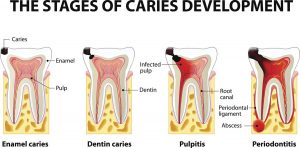What are the Periodontal Disease Stages?

Over half a billion people are estimated to be affected by periodontal disease every year. Periodontal disease often referred to simply as “gum disease”, encompasses a range of inflammatory conditions that affect the soft tissues surrounding the teeth. Fortunately, good oral hygiene and regular cleaning can help treat and reduce the risk of developing gum disease.
Did you know that there are several key stages to the development of periodontal disease? Knowing what these stages look like may help you identify the onset of gum disease early on, which can have potentially life-saving consequences in the long term. To help you understand the ins and outs of periodontal disease, we’ll explore the various stages of its development.
What Is Periodontal Disease?
Periodontal disease, otherwise known as gum disease, are inflammatory conditions marked by red, swollen, painful gums, tooth loss, bad breath, and occasionally oral bleeding. Often, these symptoms are first discovered while brushing one’s teeth or using dental floss. We encourage readers to always be mindful of these early symptoms while brushing.
A common misconception about periodontal disease is that it must be painful. While many cases of gum disease are indeed painful, a good deal of them involve little to no pain at all. These “benign” cases of gum disease are often the most serious, as patients can go a long time before they realize they need to seek medical treatment.
Causes of Periodontal Disease
When it comes to your oral health, there are few things more important than the tissue that holds your teeth in place: your gums. When your gums contract a disease, it is usually due to infections that take hold in the absence of proper brushing and flossing. Foregoing brushing and flossing can lead to excess plaque buildup, which is a breeding ground for harmful bacteria.
When bacteria accumulate in your mouth, plaque begins to develop. We often notice plaque because it grows on our teeth, which become discolored and yellow. However, many strains of plaque are colorless, which can mislead us into believing that your mouth is free of dangerous bacteria.
The truth is, only dental professionals can accurately detect whether plaque has accumulated in your mouth. Therefore, it is important that you always remain vigilant about plaque buildup by regularly scheduling dental appointments and brushing and flossing on an everyday basis.
Symptoms of Gum Disease
There are many symptoms of gum disease that need to be kept in mind. If you detect any of the following symptoms, consider speaking with your dentist about whether you might have gum disease.
Detecting Gum Disease

To make a more informed judgment, your doctor or dentist will likely ask you about your medical history and your family history of oral disease. Usually, risk factors will be discussed such as smoking tobacco or having diabetes.
In some cases, x-ray scans may be necessary to detect whether you have lost any bone tissue. If diagnosed, a dentist may refer you to a periodontist, which is a dental professional specifically trained to treat gum disease. Your periodontist will then go over your treatment options with you.
The Four Stages of Gum Disease
Now that we know the basics about gum disease, we can go over its four main developmental stages. In linear order, these four stages describe how periodontal diseases progress.
Stage 1: Gingivitis
Gingivitis is the earliest stage of periodontal disease marked by plaque buildup around one’s gum line. Upon first detection of gingivitis, diligently brush and floss your teeth. If the plaque does not begin to recede after regular cleaning, it may be advancing into more advanced stages.
This early stage of gum disease involves plaque entering the small spaces between your teeth. Gingivitis is commonly identified by bad breath, swollen gums, and bleeding while flossing. At this stage, gingivitis can be treated with basic oral hygiene practices.
Stage 2: Slight Periodontal Disease
Gingivitis can quickly advance into slight periodontal disease if left untreated. When this happens, the patient’s gum line will become visibly inflamed and redder than before. Early bone loss is sometimes present at this stage, with gingival pocket depth sometimes reaching as deep as 5 millimeters. More blood will be present during brushing at this stage.
Fortunately, non-surgical treatment options are still available at this stage. Speak with your dentist immediately if the warning signs of Stage 2 gum disease are apparent. Regular in-depth cleaning is necessary to stop the advancement into Stage 3 periodontal disease.
Stage 3: Moderate Periodontal Disease
By the time the condition advances to Stage 3, the patient will usually have been diagnosed with periodontal disease. At this point, the infection now extends deep under the gums and is eroding the bone that undergirds them. More bone loss will be apparent at this stage of the disease, and regular oral hygiene is no longer a viable treatment option.
Moderate periodontal disease is marked by probing depths up to 7 millimeters and more intense pain. The patient’s immune system will be compromised by Stage 3 gum disease since harmful plaque-based bacteria will have entered the bloodstream via the gums. Deep cleaning and close monitoring are necessary at this stage.
Stage 4: Advanced Periodontal Disease
The final stage of gum disease is characterized by extensive bone loss and loose teeth. Occasionally, teeth can fall out because of advanced periodontal disease. Up to 90% oral bone loss can occur with Stage 4 gum disease. Severe bad breath and pocket depths of over 7 millimeters are commonplace at this stage, as well as significant gum recession.
The only treatment method available at this stage is periodontal surgery or laser therapy, which are needed to clean out the deep pockets of bacteria buried under the gums and teeth. Without immediate treatment, serious and potentially grave illnesses may arise in other parts of the body due to the risk of widespread infection.
Relate Posts to Read:
Periodontal Abscess: Causes, Prevention and Treatment
